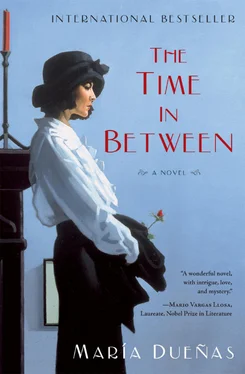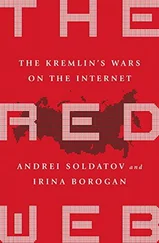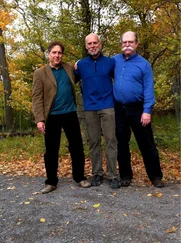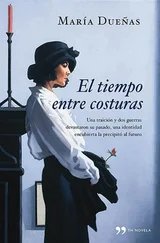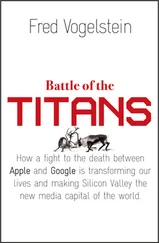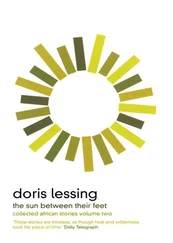María Dueñas
THE TIME IN BETWEEN
A Novel
Translated by Daniel Hahn
To my mother, Ana Vinuesa
To the Vinuesa Lope and Alvarez Moreno families,
for their old days in Tetouan
and the memories they treasured thereafter
To all former residents of the Spanish Protectorate
of Morocco,
and to the Moroccans who lived with them

THE FOUNTAIN OF CYBELE IN MADRID
Atypewriter shattered my destiny. The culprit was a Hispano-Olivetti, and for weeks, a store window kept it from me. Looking back now, from the vantage point of the years gone by, it’s hard to believe a simple mechanical object could have the power to divert the course of an entire life in just four short days, to pulverize the intricate plans on which it was built. And yet that is how it was, and there was nothing I could have done to stop it.
It wasn’t really that I was treasuring any great plans in those days. My ambitions remained close to home, almost domestic, consistent with the coordinates of the place and time in which I happened to live, plans for a future that could be within my grasp if I reached out my fingertips. At that time my world revolved slowly around a few presences that seemed to me firm and eternal. My mother had always been the most solid of them all. She was a dressmaker, working in a shop with a distinguished clientele. She was experienced and had good judgment, but she was never any more than a salaried seamstress, a working woman like so many others who for ten hours a day sacrificed her nails and pupils cutting and sewing, checking and adjusting garments destined for bodies that were not her own and gazes that would rarely be aimed at her. I knew little about my father in those days. Nothing, to be exact. He had never been around, nor did his absence affect me. I never felt much curiosity about him until my mother, when I was eight or nine, ventured to offer me a few crumbs of information. That he had another family, that it was impossible for him to live with us. I swallowed up those details with the same haste and scant appetite with which I polished off the last spoonfuls of the Lenten broth before me: the life of that alien being interested me considerably less than racing down to play in the square.
I had been born in the summer of 1911, the same year that the dancer Pastora Imperio married El Gallo, when the Mexican singer Jorge Negrete came into the world. When the star of that age they called the Belle Époque was fading. In the distance the drums of what would be the first great war were beginning to be heard, while in Madrid cafés people read El Debate and El Heraldo , and on the stage La Chelito fired men’s passions as she moved her hips brazenly to the tempo of popular songs. During those summer months King Alfonso XIII managed to arrange that, between one lover and the next, his fifth legitimate child, a daughter, was conceived. Meanwhile, at the helm of the government was Canalejas the liberal, who couldn’t predict that just a year later an eccentric anarchist would put an end to his life, firing three bullets to his head while he was browsing in the San Martín bookshop.
I grew up in reasonably happy surroundings, with more constraints than excesses but nonetheless with no great deprivations or frustrations. I was raised in a narrow street in a fusty old neighborhood in Madrid, right beside the Plaza de la Paja, just a couple of steps from the Palacio Real. A stone’s throw from the ceaseless hubbub of the heart of the city, a world of clothes hung out to dry, the smell of bleach, the voices of neighboring women, and cats lying out in the sun. I attended a makeshift school on the mezzanine of a nearby building: on its benches, meant to be used by two people, we kids arranged ourselves in fours, with no sense of order, pushing and shoving, shouting our renditions of “The Pirate’s Song” or our times tables. It was there I learned to read and write, to master the four functions of basic arithmetic as well as the names of the rivers crisscrossing the yellowed map that hung from the wall. At the age of twelve I completed my schooling and became an apprentice in the workshop where my mother worked. My logical fate.
The business of Doña Manuela Godina—the owner—had for years produced fine garments, very skillfully cut and sewn, highly regarded all over Madrid. Day dresses, cocktail dresses, coats, and cloaks that would later be shown off by distinguished ladies as they walked along La Castellana, around the Hippodrome, and the Puerta de Hierro polo club, as they took their tea at Sakuska or entered the ostentatious churches. Some time passed, however, before I began to find my way into the secrets of sewing. At first I was the whole workshop’s girl: the one who took the charcoal from the braziers and swept the cuttings from the floor, who heated the irons in the fire and ran breathless to buy thread and buttons from the Plaza de Pontejos. The one who was in charge of getting the just-finished garments, wrapped in big brown linen bags, to the exclusive residences: my favorite job, the greatest joy of my budding career. That was how I came to know the porters and chauffeurs from the best buildings, the maids, housekeepers, and butlers of the wealthiest families. I watched—unseen—the most refined of ladies, daughters, and husbands. And like a mute witness I made my way into their bourgeois houses, into aristocratic mansions and the sumptuous apartments of charming old buildings. Sometimes I wouldn’t get past the servants’ area, and someone from the household would accept delivery of the dress; at other times, I was directed to go to the dressing room, so I would make my way down corridors and catch glimpses of drawing rooms, where my eyes would feast on the carpets, chandeliers, velvet curtains, and grand pianos that sometimes were being played and sometimes not, thinking all the while how strange it would be to live in such a universe.
My days shifted effortlessly between these two worlds, and I became less and less aware of the incongruity that existed between them. I would walk down those broad roads rutted with carriage tracks and lined with large imposing doorways just as naturally as I would pass through the crazy network of winding streets that formed my neighborhood, streets filled with puddles, rubbish, the cries of vendors, and the sharp barks of hungry dogs. Where everyone always went in a hurry, and at the cry of “ Agua va! ” you had better take cover to avoid being splattered with urine. Craftsmen, minor businessmen, employees, and newspaper vendors lately arrived in the capital filled the rental houses and gave my neighborhood its villagey feel. Many of them only left its bounds when obliged to; my mother and I, on the other hand, did so early each morning, to get over to Calle Zurbano and quickly buckle down to our day-to-day tasks in Doña Manuela’s workshop.
After my first two years as an apprentice, the two of them decided that the time had come for me to learn how to sew. At fourteen, I started with the simplest things: fasteners, overcasting, loose tacking. Then came buttonholes, backstitches, and hems. We worked seated on little rush chairs, hunched over wooden boards supported on our knees, where we placed the fabric we were sewing. Doña Manuela dealt with the customers, cutting, checking, and correcting. My mother took the measurements and dealt with all the rest: she did the most delicate needlework and assigned the remainder of the jobs, supervising their execution and imposing rhythm and discipline on a small battalion consisting of half a dozen older dressmakers, four or five young women, and a number of chatterbox apprentice girls, always keener on laughing and gossiping than on doing their work.
Читать дальше
